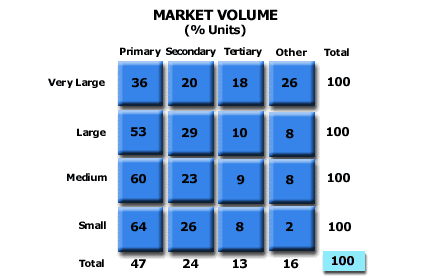Analysis 14: Customer Size Segments’ Allocation of Volume By Role
EXHIBITS:

| HOW TO INTERPRET THE ANALYSIS: The average customer in this industry allocated 47% of its total purchases to its Primary Role supplier, 24% to the Secondary Role supplier and 18% to the Tertiary Role supplier. The larger the customer, however, the less the customer allocated to its Primary Role supplier. For example, Very Large customers allocated only 36% of their total purchases to their Primary supplier and 20% to their Secondary supplier. On the other hand, Small customers allocate 64% of their total purchases to their Primary Role supplier and 26% to their Secondary.
PURPOSE: This analysis enables the company to see how customer size segments change their volume allocation by role position in their relationships. This analysis enables the company to form its expectations on the amount of volume it might expect from an average customer of each size in each role. The analysis is most useful when little data about the prospective customer is available. APPROACH: The company sums the total customer sample volume by size of customer and by each role the size segment uses. By dividing the total volume that Very Large customers use in their primary positions by the total volume of the Very Large customer sample, the company arrives at the percentage of the average relationship that a Very Large customer will allocate to the primary position. The other positions on the matrix are completed in the same manner. The company reads this analysis from left to right. For example, in the Very Large customer segment, the primary role position on average commands 36% of the total purchases of the average Very Large customer. The secondary holds 20%, tertiary 18%, and all other roles 26%. In the total market, the average primary position holds 47% of the customer's volume. The numbers in the horizontal total column are useful in gaining a perspective on the basic size of each role. The company can compare this basic sizes to the size of the roles in each customer size segment. For example, Very Large customers tend to be more spread out geographically in this market and must maintain more suppliers than do small customers. As a result, the primary position of the Very Large customer offers less of a percentage of the customer's total purchases than does the primary position with a small customer, who operates within a shorter geographic radius. |
|
Recommended Reading |
| For a greater overall perspective on this subject, we recommend the following related items:
Analyses: Symptoms and Implications: Symptoms developing in the market that would suggest the need for this analysis.
Perspectives: Conclusions we have reached as a result of our long-term study and observations.
|
